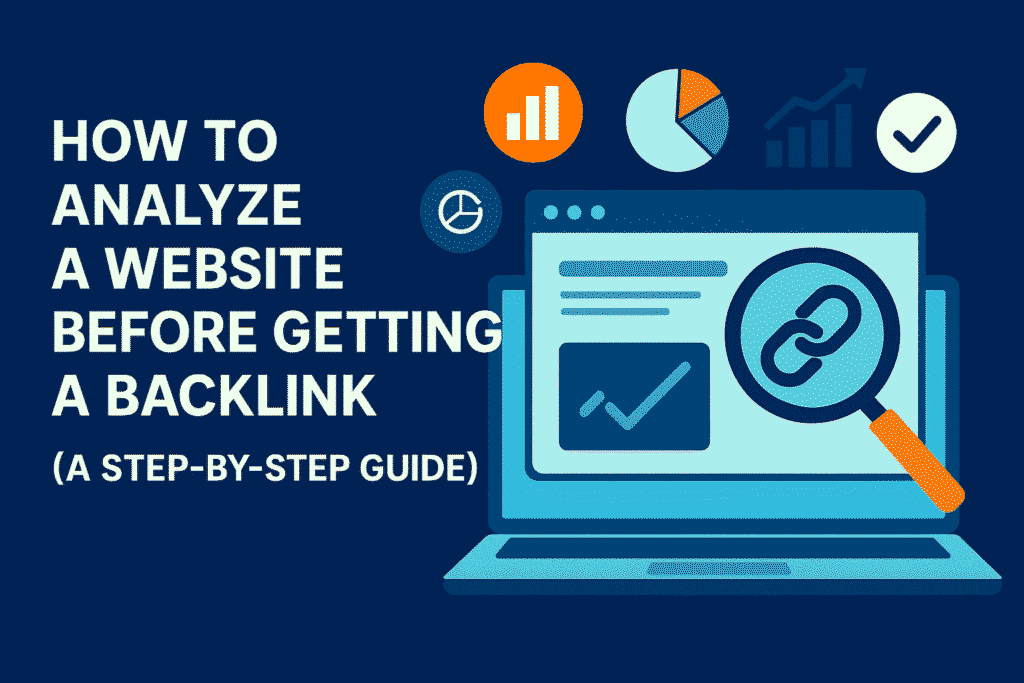
Contents
Backlinks remain one of the most critical ranking factors in SEO. A single high-quality backlink from an authoritative website can boost your rankings, while a spammy link can trigger Google penalties and harm your site’s credibility.
But how do you determine if a website is worth getting a backlink from? Not all backlinks are created equal—some can propel your SEO efforts, while others can drag your site down.
In this article, we’ll walk you through a step-by-step process to analyze a website before link-building. By the end, you’ll know exactly what to look for to ensure you’re getting high-quality, relevant, and safe backlinks.
First, be sure you understand What is Link Building? and Why Link Building is Important for SEO?
Check Domain Authority & Trustworthiness
Domain Authority (DA) & Domain Rating (DR)
- What It Means: DA (Moz) and DR (Ahrefs) measure a website’s strength on a scale of 0-100. Higher scores indicate stronger authority.
- Why It Matters: Links from high-DA/DR sites pass more SEO value.
- How to Check:
- Use Moz’s Link Explorer (for DA)
- Use Ahrefs’ Site Explorer (for DR)
- Benchmark:
- DA/DR 70+: Excellent (Very authoritative)
- DA/DR 40-70: Good (Still valuable)
- DA/DR Below 30: Proceed with caution (May not pass much SEO value)
Age of Domain
- Older domains (5+ years) are generally more trusted by Google.
- Use Whois Lookup (whois.domaintools.com) to check the domain registration date.
Site Reputation
- Search
site:example.comon Google to see if the site is indexed. - Look for negative reviews or spam reports (e.g., “Is [website] a scam?”).
You’ll need tools like those mentioned in Best Link Building Tools for Beginners & Pros in 2025.
Evaluate Traffic & Engagement Metrics
Organic Traffic (Is the Site Getting Real Visitors?)
- Use SimilarWeb or SEMrush to estimate traffic.
- A site with 10,000+ monthly visitors is usually a good candidate.
Bounce Rate & Avg. Session Duration
- High bounce rates (>70%) may indicate poor content quality.
- Long session durations (>2 minutes) suggest engaging content.
Geographic Relevance
- If you’re targeting US-based customers, ensure the site gets traffic from the US.
- Check traffic distribution in Google Analytics (if shared) or SimilarWeb.
Assess Content Quality & Relevance
Is the Content Well-Written & Original?
- Look for grammar errors, thin content, or AI-generated spam.
- Use Copyscape to check for duplicate content.
Topic Relevance
- A backlink from a related niche is more valuable than an unrelated one.
- Example: A fitness blog linking to your supplement store is relevant; a gaming site linking to it is not.
User Engagement
- Check comments, social shares, and backlinks to their content.
- High engagement = Stronger link value.
Analyze Backlink Profile (Who’s Linking to Them?)
Spam Score (Moz)
- A high spam score (>30%) means the site may be risky.
Linking Domains
- Use Ahrefs’ Backlink Checker to see if reputable sites link to them.
- Avoid sites with toxic backlinks (gambling, adult, PBNs).
Anchor Text Diversity
- Too many exact-match keywords (e.g., “best weight loss pills”) can look unnatural.
- Healthy profiles have branded, generic, and natural anchors.
Check for Penalties & Indexing Status
Is the Site Indexed by Google?
- Search
site:example.com—if few/no results appear, the site may be penalized.
Google Penalties
- Use Google Search Console (if available) to check for manual actions.
- Check Wayback Machine (archive.org) for past shady practices.
Review On-Page SEO & Technical Health
Site Speed (GTmetrix, PageSpeed Insights)
- Slow sites (load time >3 seconds) hurt user experience and rankings.
Mobile-Friendliness (Google Mobile-Friendly Test)
- A non-mobile-friendly site may lose rankings.
HTTPS Security & Clean URLs
- Avoid sites with mixed content warnings or unsecured HTTP.
Assess Social Signals & Brand Mentions
Social Media Presence
- Active profiles on LinkedIn, Twitter, Facebook indicate legitimacy.
Brand Mentions (Google Search "brand name" -site:brand.com)
- See if reputable sites mention them organically.
Avoid Toxic & PBN Sites
Signs of a PBN (Private Blog Network):
- Same IP hosting as other unrelated sites.
- Low-quality content with excessive outbound links.
Toxic Link Indicators:
- Sudden traffic drops (check SimilarWeb trends).
- Links from spammy directories or irrelevant sites.
Conclusion
Getting a backlink is easy—getting a high-quality, safe, and relevant one takes effort. Before accepting or requesting a backlink, always:
- Check Domain Authority & Traffic
- Analyze Content Quality & Relevance
- Review Backlink Profile for Red Flags
- Ensure No Google Penalties
- Avoid PBNs & Spammy Sites
By following this guide, you’ll build a strong, penalty-free backlink profile that boosts your rankings safely.
